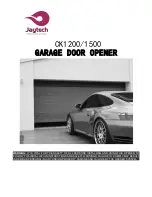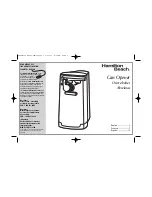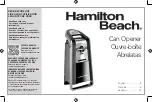
3 - SETTING THE DIPSWITCHES
4 - LINEAR POTENTIOMETERS
- Adjustments to the potentiometers will only take effect after the system has reached to the end of a cycle,
i.e. when the gate closed or when the system has been reset (power off). Make sure that you let the adjustments
take effect before readjusting.
- Adjusting the POWER potentiometers will require repeating the Automatic gate travel learning
POWER AND SPEED
potentiometer adjusts the force and speed of the motor(s). Use this to adjust the
pushing-force and for fine control over the speed (basic speed is determined by DipSwitch-1).
Adjustment range is 30% to 100%. Adjust this potentiometer to have enough power to push against
a 15 -35kg object that is 2 meters from the wing’s hinges. (If the wing(s) are too sensitive to obstacles
increase (+) the OBSTACLE potentiometer slightly)
Typical position - near maximum
Remember: adjusting the power pot. will take effect only after doingthe gate travel learning (sec.9)
OBSTACLE
potentiometer is the anti-crush control. This determines the motor’s pushing force limit and
the time it takes the motor(s) to cut-out after hitting an obstacle. Increase (+) this adjustment when more
force is needed. Eg. for gates made of full steel, cast iron, colorbond (sheet metal), and for gates in windy
areas. Cut out range time is 0.1 to 3 seconds
- For windy arias, wooden and colorbond gates – increase the obstacle level slightly
- This potentiometer also controls the pressure against the travel stoppers. Check manual override operation after adjusting
this potentiometer
Typical position - near maximum
PAUSE
potentiometer determines the delay time at the open position before automatically closing.
(for auto-closing modes only). The delay range is 1 to 90 seconds.
- Remember: let the cycle finish before readjusting
DELAY
between the wings in opening and closing. This potentiometer controls the delay between MOT 1 and MOT 2
(wing 1 and wing 2). Use this delay when wings overlap or when using an electric lock. The delay range is 0 to 15 seconds.
- Remember for single wing gates - this potentiometer should be set to 0 (zero).
- DipSwitches settings will only take effect after the system has reached the end of a cycle. i.e.
when the gate closed or when the system has been reset (power off, battery and mains)
DIP sw.1 needs to be set BEFORE the gate travel learning
5 - PROGRAMMING THE REMOTE CONTROL FOR MAIN VEHICLE ACCESS - FULL OPENING
4
5
DS-1: Motor
ON
OFF
Folding arm Modus,Minimodus
Linear, Jet, Couper
Motor type (to set before gate travel learning)
DS-4: Photo sensor-2
ON
OFF
Photo-sensor intervenes in opening and closing
Safety edge operation
PHO2 input - terminal 17, setting
DS-5: Hazard Light
ON
OFF
ON
OFF
Connected light will flash during the cycle
Connected light will be steady on during the cycle
Hazard Light output (terminals 10 & 19) setting
DS-6: Kick-back
Before opening, the gate shortly pushes to closing (for lock release).for hydraulic rams
Kickback is disabled
Kick-back (Water hammer) on start
ON
OFF
DS-7: Close After Photo
Gate closes immediately once photo-sensor is cleared
Close after Photo disabled
Close immediately after vehicle clears the photocell
ON
OFF
DS-8: Remote Control
Programming
Vehicle (full) opening
Pedestrian opening
Remote Control Programming setting
vehicle / pedestrian access (see sections 5, 6 and 11)
DS-2: STEP
ON
ON
OFF
OFF
DS-3: AUTO
ON
OFF
ON
OFF
Auto-Closing with intervention by remote /command
Step-by-step: open / stop / close / stop ....
Fully Automatic, always close, (condominium)
Open / close /open (no stop when opening)
Operation mode setting
1) Make sure that:
A) Power – ON
B) DipSwitch 8 - ON
2) Press the
RADIO
button in the control box for 3 seconds
the RADIO-LED turns on
3) Choose the remote’s button you want to use for vehicle access opening
(usually the large one) and press it
The RADIO-LED flashes shortly
For programming more remotes – repeat step 3
4) Press the
RADIO
button again to exit the programming mode
If no key is pressed, programming mode will automatically exit after 10 seconds!
6 - PROGRAMMING REMOTE CONTROL PEDESTRIAN ACCESS
1) Move DipSwitch 8 to OFF
2) Press the RADIO button in the control box for 3 seconds
the RADIO LED turns on
3) Choose the remote’s button you want to use for PEDESTRIAN- ACCESS
opening (usually the smallest one) and press it
the RADIO LED will flashes shortly
For programming more remotes - repaid this process one after the other
4) Press the RADIO button again to exit the programming mode
If no key is pressed, programming mode will automatically exit after 10 seconds!
5) Move Dip SW 8 to ON (reccomended)
7 - DELETING ALL THE REMOTE CONTROLS FROM THE CONTROL BOX
1) Press the RADIO button for 4 seconds and release
the RADIO-LED starts flashing
2) While it flashes, press the RADIO button again until
the RADIO-LED flashing rapidly
All remotes deleted
8 - HOW TO ADJUST THE OBSTACLE, POWER AND SPEED WITH THE POTENTIOMETERS
1) Make sure that DipSwitch 2 is ON & DipSwitch 3 is OFF - step-by-step mode
2) Engage (Open) the manual override lever and move the wings to half way, then disengage (close) the manual
override
3) Before operating the gate consider all safety requirements (see paragraph 1)
4) Operate the gate with a remote control (or with the START button) and check the force, torque while the wings
are moving
- adjust the speed with the POWER potentiometer (
Typical position is near maximum)
- Remember; changes will only take effect at the end of the cycle
- High / low BASIC speed is determine by DipSwitch 1
5) Carefully check that the gate has enough power to push against a 15 -35kg object. Adjust it with the OBSTA-
CLE potentiometer
- Measure the force about 2 meters from the wing hinge
- If the motor force is not sufficient, increase the power slightly by adjusting the POWER potentiometers
(
Typical position is near maximum)
- For windy sites, wooden or colorbond gate – increase the obstacle level slightly (for more details see section 4)
Содержание Star 224
Страница 11: ...11...






























